light YAMAHA BT1100 2002 User Guide
[x] Cancel search | Manufacturer: YAMAHA, Model Year: 2002, Model line: BT1100, Model: YAMAHA BT1100 2002Pages: 96, PDF Size: 3.32 MB
Page 37 of 96
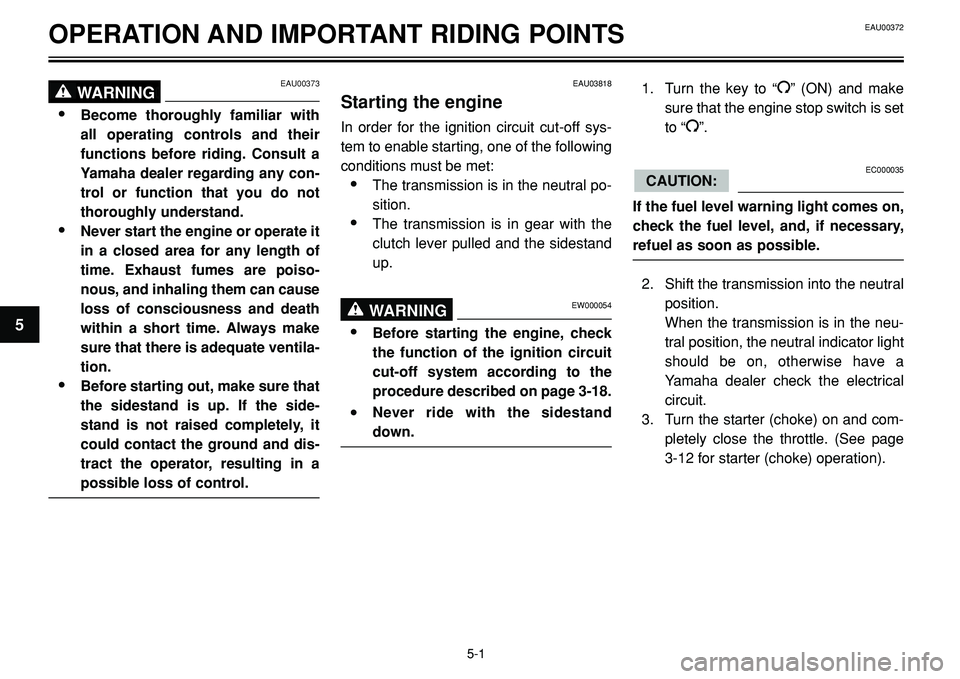
OPERATION AND IMPORTANT RIDING POINTS
EAU00373WARNING0
•Become thoroughly familiar with
all operating controls and their
functions before riding. Consult a
Yamaha dealer regarding any con-
trol or function that you do not
thoroughly understand.
•Never start the engine or operate it
in a closed area for any length of
time. Exhaust fumes are poiso-
nous, and inhaling them can cause
loss of consciousness and death
within a short time. Always make
sure that there is adequate ventila-
tion.
•Before starting out, make sure that
the sidestand is up. If the side-
stand is not raised completely, it
could contact the ground and dis-
tract the operator, resulting in a
possible loss of control.
EAU03818
Starting the engine
In order for the ignition circuit cut-off sys-
tem to enable starting, one of the following
conditions must be met:
•The transmission is in the neutral po-
sition.
•The transmission is in gear with the
clutch lever pulled and the sidestand
up.
EW000054WARNING0
•Before starting the engine, check
the function of the ignition circuit
cut-off system according to the
procedure described on page 3-18.
•Never ride with the sidestand
down.
1. Turn the key to “I” (ON) and make
sure that the engine stop switch is set
to “
I”.
EC000035
If the fuel level warning light comes on,
check the fuel level, and, if necessary,
refuel as soon as possible.
2. Shift the transmission into the neutral
position.
When the transmission is in the neu-
tral position, the neutral indicator light
should be on, otherwise have a
Yamaha dealer check the electrical
circuit.
3. Turn the starter (choke) on and com-
pletely close the throttle. (See page
3-12 for starter (choke) operation).
CAUTION:
5-1
5
EAU00372
Page 38 of 96
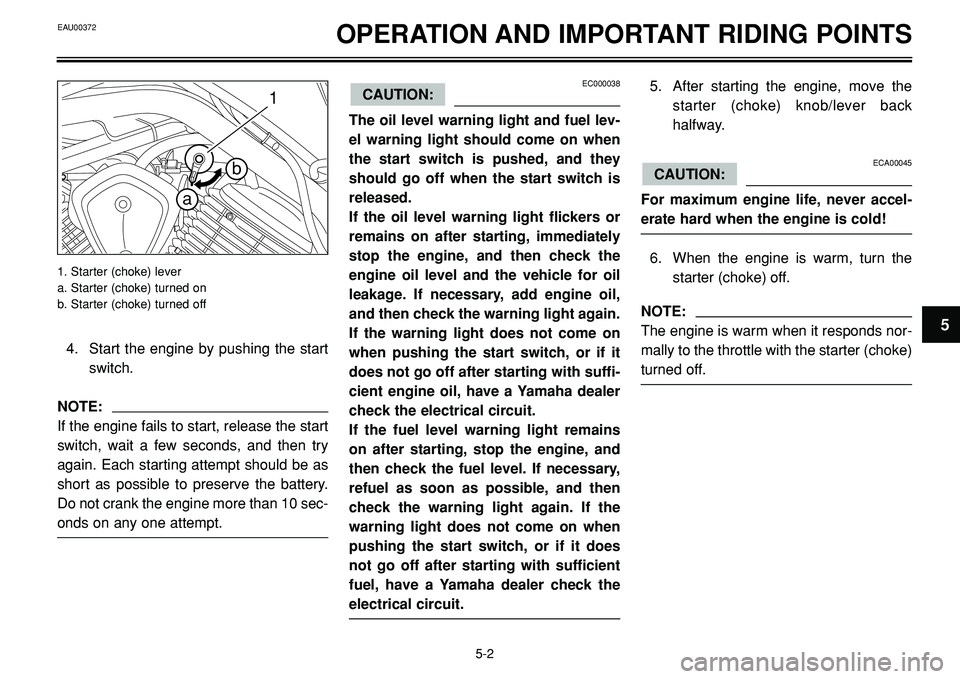
OPERATION AND IMPORTANT RIDING POINTS
1
b
a
4. Start the engine by pushing the start
switch.
NOTE:
If the engine fails to start, release the start
switch, wait a few seconds, and then try
again. Each starting attempt should be as
short as possible to preserve the battery.
Do not crank the engine more than 10 sec-
onds on any one attempt.
1. Starter (choke) lever
a. Starter (choke) turned on
b. Starter (choke) turned off
EC000038
The oil level warning light and fuel lev-
el warning light should come on when
the start switch is pushed, and they
should go off when the start switch is
released.
If the oil level warning light flickers or
remains on after starting, immediately
stop the engine, and then check the
engine oil level and the vehicle for oil
leakage. If necessary, add engine oil,
and then check the warning light again.
If the warning light does not come on
when pushing the start switch, or if it
does not go off after starting with suffi-
cient engine oil, have a Yamaha dealer
check the electrical circuit.
If the fuel level warning light remains
on after starting, stop the engine, and
then check the fuel level. If necessary,
refuel as soon as possible, and then
check the warning light again. If the
warning light does not come on when
pushing the start switch, or if it does
not go off after starting with sufficient
fuel, have a Yamaha dealer check the
electrical circuit.
CAUTION:5. After starting the engine, move the
starter (choke) knob/lever back
halfway.
ECA00045
For maximum engine life, never accel-
erate hard when the engine is cold!
6. When the engine is warm, turn the
starter (choke) off.
NOTE:
The engine is warm when it responds nor-
mally to the throttle with the starter (choke)
turned off.
CAUTION:
EAU00372
5-2
5
Page 39 of 96

OPERATION AND IMPORTANT RIDING POINTS
1
5
4
3
2
N
1
EAU01258
Starting a warm engine
Follow the same procedure as for starting
a cold engine with the exception that the
starter (choke) is not required when the
engine is warm.
EAU00423
Shifting
Shifting gears lets you control the amount
of engine power available for starting off,
accelerating, climbing hills, etc.
The gear positions are shown in the illus-
tration.
NOTE:
To shift the transmission into the neutral
position, press the shift pedal down
repeatedly until it reaches the end of its
travel, and then slightly raise it.
EC000048
•Even with the transmission in the
neutral position, do not coast for
long periods of time with the
engine off, and do not tow the
motorcycle for long distances. The
transmission is properly lubricat-
ed only when the engine is run-
ning. Inadequate lubrication may
damage the transmission.
•Always use the clutch while
changing gears to avoid damaging
the engine, transmission, and dri-
ve train, which are not designed to
withstand the shock of forced
shifting.
CAUTION:
5-3
5
1. Shift pedal
N. Neutral position
EAU00372
Page 40 of 96

OPERATION AND IMPORTANT RIDING POINTS
EAU00424
Tips for reducing fuel
consumption
Fuel consumption depends largely on your
riding style. Consider the following tips to
reduce fuel consumption:
•Thoroughly warm up the engine.
•Turn the starter (choke) off as soon
as possible.
•Shift up swiftly, and avoid high engine
speeds during acceleration.
•Do not rev the engine while shifting
down, and avoid high engine speeds
with no load on the engine.
•Turn the engine off instead of letting it
idle for an extended length of time
(e.g., in traffic jams, at traffic lights or
at railroad crossings).
5-4
5
EAU00372
EAU01128
Engine break-in
There is never a more important period in
the life of your engine than the period be-
tween 0 and 1,600 km (1,000 mi). For this
reason, you should read the following ma-
terial carefully.
Since the engine is brand new, do not put
an excessive load on it for the first 1,600
km (1,000 mi). The various parts in the en-
gine wear and polish themselves to the
correct operating clearances. During this
period, prolonged full-throttle operation or
any condition that might result in engine
overheating must be avoided.
EAU01171
0-1,000 km (0-600 mi)
Avoid prolonged operation above 1/3 throt-
tle.
1,000-1,600 km (600-1,000 mi)
Avoid prolonged operation above 1/2 throt-
tle.
EC000056
After 1,000 km (600 mi) of operation,
the engine oil and final gear oil must be
changed, and the oil filter cartridge/ele-
ment replaced.
1,600 km (1,000 mi) and beyond
The vehicle can now be operated normal-
ly.
EC000049
If any engine trouble should occur dur-
ing the engine break-in period, immedi-
ately have a Yamaha dealer check the
vehicle.
CAUTION:
CAUTION:
Page 42 of 96
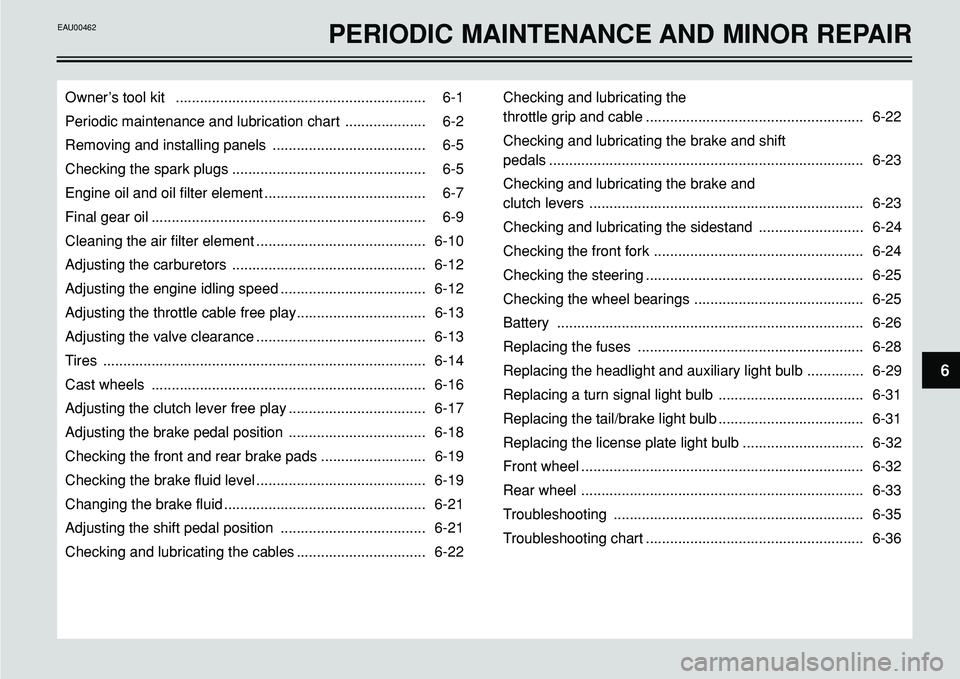
6
Owner’s tool kit .............................................................. 6-1
Periodic maintenance and lubrication chart .................... 6-2
Removing and installing panels ...................................... 6-5
Checking the spark plugs ................................................ 6-5
Engine oil and oil filter element ........................................ 6-7
Final gear oil .................................................................... 6-9
Cleaning the air filter element .......................................... 6-10
Adjusting the carburetors ................................................ 6-12
Adjusting the engine idling speed .................................... 6-12
Adjusting the throttle cable free play................................ 6-13
Adjusting the valve clearance .......................................... 6-13
Tires ................................................................................ 6-14
Cast wheels .................................................................... 6-16
Adjusting the clutch lever free play .................................. 6-17
Adjusting the brake pedal position .................................. 6-18
Checking the front and rear brake pads .......................... 6-19
Checking the brake fluid level .......................................... 6-19
Changing the brake fluid .................................................. 6-21
Adjusting the shift pedal position .................................... 6-21
Checking and lubricating the cables ................................ 6-22Checking and lubricating the
throttle grip and cable ...................................................... 6-22
Checking and lubricating the brake and shift
pedals .............................................................................. 6-23
Checking and lubricating the brake and
clutch levers .................................................................... 6-23
Checking and lubricating the sidestand .......................... 6-24
Checking the front fork .................................................... 6-24
Checking the steering ...................................................... 6-25
Checking the wheel bearings .......................................... 6-25
Battery ............................................................................ 6-26
Replacing the fuses ........................................................ 6-28
Replacing the headlight and auxiliary light bulb .............. 6-29
Replacing a turn signal light bulb .................................... 6-31
Replacing the tail/brake light bulb .................................... 6-31
Replacing the license plate light bulb .............................. 6-32
Front wheel ...................................................................... 6-32
Rear wheel ...................................................................... 6-33
Troubleshooting .............................................................. 6-35
Troubleshooting chart ...................................................... 6-36
PERIODIC MAINTENANCE AND MINOR REPAIREAU00462
Page 46 of 96

EAU00462PERIODIC MAINTENANCE AND MINOR REPAIR
EAU03884
NOTE:
•The air filter needs more frequent service if you are riding in unusually wet or dusty areas.
•Hydraulic brake service
•Regularly check and, if necessary, correct the brake fluid level.
•Every two years replace the internal components of the brake master cylinders and calipers, and change the brake fluid.
•Replace the brake hoses every four years and if cracked or damaged.
6-4
6
ODOMETER READING (x 1,000 km)ANNUALN0. ITEM CHECK OR MAINTENANCE JOB
1 10203040CHECK
Rear suspension
•Check operation. √√√√
20*relay arm and
connecting arm
•Lubricate with lithium-soap-based grease.√√
pivoting points
•Check starter (choke) operation.
21
*Carburators•Adjust engine idling speed and √√ √√ √ √synchronization.
22 Engine oil•Change.√√ √√ √ √
23Engine oil filter
•Replace. √√√
element
•Check oil level and vehicle for oil
√√ √
24Final gear
leakage.oil
•Change.√√√
25Moving parts and
•Lubricate.√√√√ √
cables
•Check the air cut valve and reed valve for
26
*Air induction
damage.
√√√√ √
system
•Replace the entire air induction system if
necessary.
27
*Lights, signals and •Check operation.
√√ √√ √ √
switches•Adjust headlight beam.
Page 48 of 96
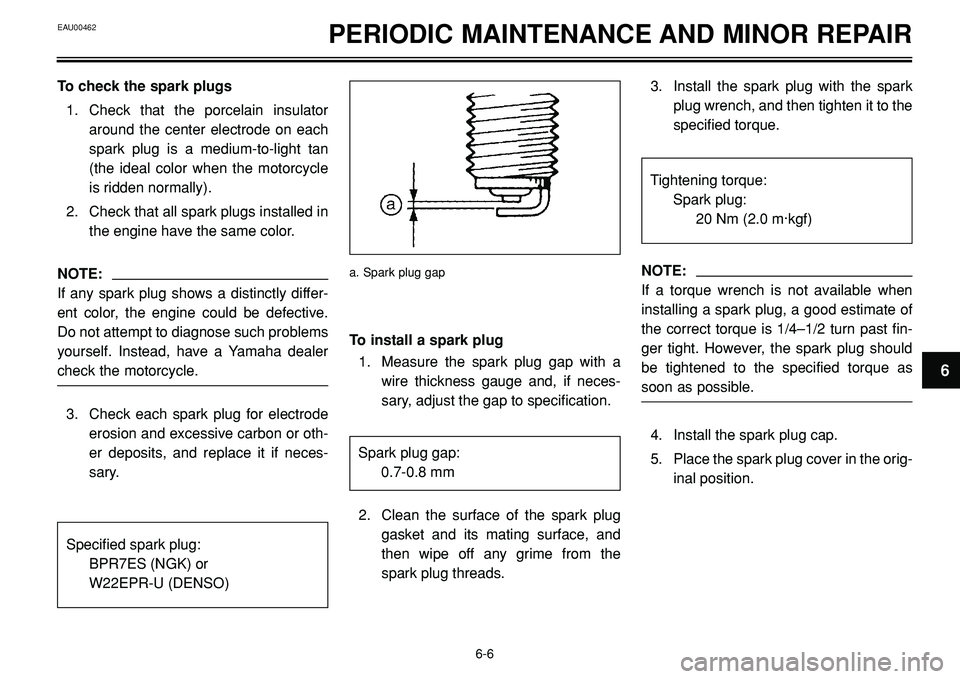
EAU00462PERIODIC MAINTENANCE AND MINOR REPAIR
To install a spark plug
1. Measure the spark plug gap with a
wire thickness gauge and, if neces-
sary, adjust the gap to specification.
2. Clean the surface of the spark plug
gasket and its mating surface, and
then wipe off any grime from the
spark plug threads.3. Install the spark plug with the spark
plug wrench, and then tighten it to the
specified torque.
NOTE:
If a torque wrench is not available when
installing a spark plug, a good estimate of
the correct torque is 1/4–1/2 turn past fin-
ger tight. However, the spark plug should
be tightened to the specified torque as
soon as possible.
4. Install the spark plug cap.
5. Place the spark plug cover in the orig-
inal position.
6-6
6
a. Spark plug gap
To check the spark plugs
1. Check that the porcelain insulator
around the center electrode on each
spark plug is a medium-to-light tan
(the ideal color when the motorcycle
is ridden normally).
2. Check that all spark plugs installed in
the engine have the same color.
NOTE:
If any spark plug shows a distinctly differ-
ent color, the engine could be defective.
Do not attempt to diagnose such problems
yourself. Instead, have a Yamaha dealer
check the motorcycle.
3. Check each spark plug for electrode
erosion and excessive carbon or oth-
er deposits, and replace it if neces-
sary.
Specified spark plug:
BPR7ES (NGK) or
W22EPR-U (DENSO)
Tightening torque:
Spark plug:
20 Nm (2.0 m·kgf)
Spark plug gap:
0.7-0.8 mm
Page 49 of 96

EAU00462
1. Engine oil filler cap
PERIODIC MAINTENANCE AND MINOR REPAIR
1
NOTE:
Make sure that the motorcycle is posi-
tioned straight up when checking the oil
level. A slight tilt to the side can result in a
false reading.
2. Start the engine, warm it up for sever-
al minutes, and then turn it off.
3. Wait a few minutes until the oil set-
tles, and then check the oil level
through the check window located at
the bottom-left side of the crankcase.
NOTE:
The engine oil should be between the min-
imum and maximum level marks.
4. If the engine oil is below the minimum
level mark, add sufficient oil of the
recommended type to raise it to the
correct level.To change the engine oil without oil
filter element replacement
1. Start the engine, warm it up for sever-
al minutes, and then turn it off.
2. Place an oil pan under the engine to
collect the used oil.
3. Remove the engine oil filler cap and
drain bolt to drain the oil from the
crankcase.
6-7
6
2
31
EAU01712
Engine oil and oil filter element
The engine oil level should be checked be-
fore each ride. In addition, the oil must be
changed and the oil filter element replaced
at the intervals specified in the periodic
maintenance and lubrication chart.
To check the engine oil level
1. Place the motorcycle on a level sur-
face and hold it in an upright position.
1. Engine oil level window
2. Maximum level mark
3. Minimum level mark
Page 50 of 96

EAU00462PERIODIC MAINTENANCE AND MINOR REPAIR
EC000072
•In order to prevent clutch slippage
(since the engine oil also lubri-
cates the clutch), do not mix any
chemical additives with the oil or
use oils of a higher grade than
“CD”. In addition, do not use oils
labeled "ENERGY CONSERVING II"
or higher.
•Make sure that no foreign material
enters the crankcase.
CAUTION:6. Start the engine, and then let it idle for
several minutes while checking it for
oil leakage. If oil is leaking, immedi-
ately turn the engine off and check for
the cause.
NOTE:
After the engine is started, the engine oil
level warning light should go off if the oil
level is sufficient.
EC000067
If the oil level warning light flickers or
remains on, immediately turn the
engine off and have a Yamaha dealer
check the vehicle.
7. Turn the engine off, and then check
the oil level and correct it if neces-
sary.
NOTE:
Have a Yamaha dealer replace the oil filter
element when necessary.
CAUTION:
1. Engine oil drain bolt
6-8
6
1
4. Install the engine oil drain bolt, and
then tighten it to the specified torque.
5. Add the specified amount of the rec-
ommended engine oil, and then in-
stall and tighten the oil filler cap. Tightening torque:
Engine oil drain bolt:
43 Nm (4.3 m·kgf)
Recommended engine oil:
See page 8-1.
Oil quantity:
Without oil filter element
replacement:
3.0 L
With oil filter element
replacement:
3.1 L
Total amount (dry engine):
3.6 L
Page 51 of 96
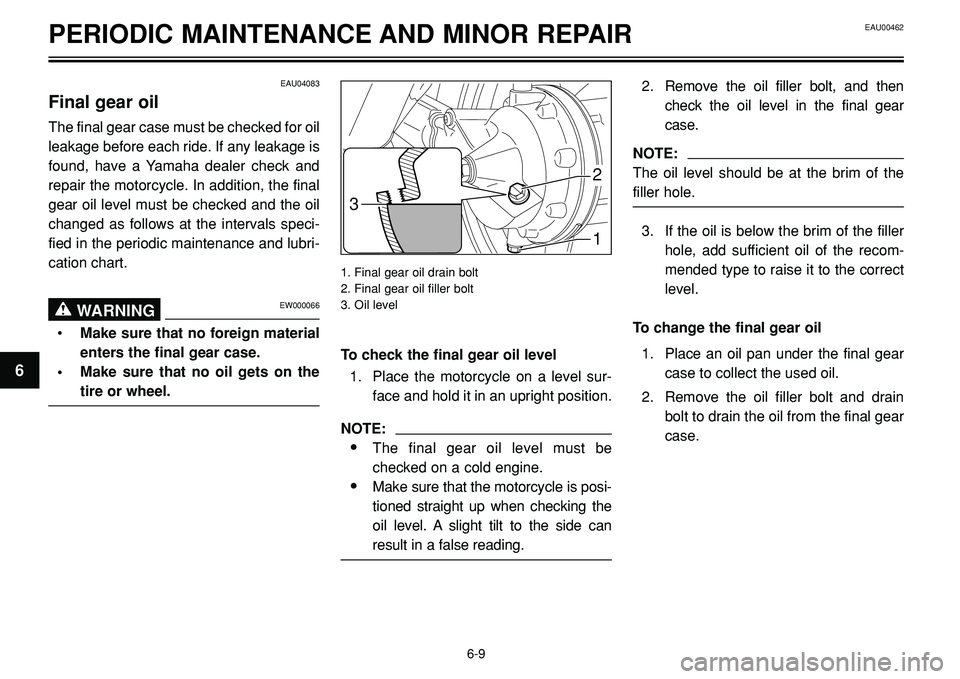
EAU00462PERIODIC MAINTENANCE AND MINOR REPAIR
3
1 2
To check the final gear oil level
1. Place the motorcycle on a level sur-
face and hold it in an upright position.
NOTE:
•The final gear oil level must be
checked on a cold engine.
•Make sure that the motorcycle is posi-
tioned straight up when checking the
oil level. A slight tilt to the side can
result in a false reading.2. Remove the oil filler bolt, and then
check the oil level in the final gear
case.
NOTE:
The oil level should be at the brim of the
filler hole.
3. If the oil is below the brim of the filler
hole, add sufficient oil of the recom-
mended type to raise it to the correct
level.
To change the final gear oil
1. Place an oil pan under the final gear
case to collect the used oil.
2. Remove the oil filler bolt and drain
bolt to drain the oil from the final gear
case.
6-9
6
1. Final gear oil drain bolt
2. Final gear oil filler bolt
3. Oil level
EAU04083
Final gear oil
The final gear case must be checked for oil
leakage before each ride. If any leakage is
found, have a Yamaha dealer check and
repair the motorcycle. In addition, the final
gear oil level must be checked and the oil
changed as follows at the intervals speci-
fied in the periodic maintenance and lubri-
cation chart.
EW000066WARNING0
•Make sure that no foreign material
enters the final gear case.
• Make sure that no oil gets on the
tire or wheel.